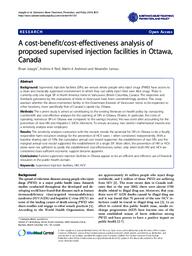Andresen, Martin A.
Person Preferred Name
Martin A. Andresen
Related Works
Content type
Digital Document
Abstract
In August, 2009 a Closed Circuit Television (CCTV) pilot project commenced at the Scott Road Skytrain Station Park and Ride in Surrey, BC. The pilot project was implemented by the City of Surrey and scheduled for one year. This document reports on an evaluation of the CCTV system with respect to its ability to reduce auto-related crime and fear of crime at the pilot site. Using several sources of data including PRIME-BC crime incidents, ICBC insurance claim incidents, and results of victimization surveys, the evaluation considers the trends of auto-related crimes over several years in the City of Surrey and the northern district of the Corporation of Delta, BC. While the reductions in auto-related crime were large enough in magnitude to conclude that the CCTV system was effective, without further investigation it is difficult to quantify the decrease. Significant reductions in fear of crime were also identified.
Origin Information
Content type
Digital Document
Abstract
Conventionally calculated crime rates are plagued with the selection of the population at risk of criminal victimization. Recent crime analysis research has employed a new measure of the population at risk, the ambient population, but this new measurement of the population at risk has not undergone much external evaluation. We use land use data to measure population attractors as an evaluation of the ambient population estimates. We find that land use is not a good predictor of population increases predicted by the ambient population.
Origin Information
Content type
Digital Document
Abstract
In August 2009, a closed-circuit television (CCTV) pilot project commenced at the Scott Road Skytrain Station Park and Ride in Surrey, BC. This article is an evaluation of the CCTV system with respect to its ability to reduce vehicle-related crime and fear of crime at the pilot site. Using results of victimization surveys, the evaluation considers the trends of vehicle-related crimes over 2 years at the car park. Although the reductions in vehicle-related crime are large enough in magnitude to conclude that the CCTV system was effective, without further investigation it is difficult to quantify the decrease. Significant reductions in fear of crime are also identified, but these reductions vary by demographic factors.
Origin Information
Content type
Digital Document
Abstract
Background:
This paper will determine whether expanding Insite (North America’s first and only supervised injection facility) to more locations in Canada such as Montreal, cost less than the health care consequences of not having such expanded programs for injection drug users.
<p>Methods:
By analyzing secondary data gathered in 2012, this paper relies on mathematical models to estimate the number of new HIV and Hepatitis C (HCV) infections prevented as a result of additional SIF locations in Montreal.
<p>Results:
With very conservative estimates, it is predicted that the addition of each supervised injection facility (up-to a maximum of three) in Montreal will on average prevent 11 cases of HIV and 65 cases of HCV each year. As a result, there is a net cost saving of CDN$0.686 million (HIV) and CDN$0.8 million (HCV) for each additional supervised injection site each year. This translates into a net average benefit-cost ratio of 1.21: 1 for both HIV and HCV.
<p>Conclusions:
Funding supervised injection facilities in Montreal appears to be an efficient and effective use of financial resources in the public health domain.
Origin Information
Content type
Digital Document
Abstract
Background: Supervised injection facilities (SIFs) are venues where people who inject drugs (PWID) have access to a clean and medically supervised environment in which they can safely inject their own illicit drugs. There is currently only one legal SIF in North America: Insite in Vancouver, British Columbia, Canada. The responses and feedback generated by the evaluations of Insite in Vancouver have been overwhelmingly positive. This study assesses whether the above mentioned facility in the Downtown Eastside of Vancouver needs to be expanded to other locations, more specifically that of Canada’s capital city, Ottawa.
<p>Methods: The current study is aimed at contributing to the existing literature on health policy by conducting cost-benefit and cost-effective analyses for the opening of SIFs in Ottawa, Ontario. In particular, the costs of operating numerous SIFs in Ottawa was compared to the savings incurred; this was done after accounting for the prevention of new HIV and Hepatitis C (HCV) infections. To ensure accuracy, two distinct mathematical models and a sensitivity analysis were employed.
<p>Results: The sensitivity analyses conducted with the models reveals the potential for SIFs in Ottawa to be a fiscally responsible harm reduction strategy for the prevention of HCV cases – when considered independently. With a baseline sharing rate of 19%, the cumulative annual cost model supported the establishment of two SIFs and the marginal annual cost model supported the establishment of a single SIF. More often, the prevention of HIV or HCV alone were not sufficient to justify the establishment cost-effectiveness; rather, only when both HIV and HCV are considered does sufficient economic support became apparent.
<p>Conclusions: Funded supervised injection facilities in Ottawa appear to be an efficient and effective use of financial resources in the public health domain.
Origin Information
Content type
Digital Document
Abstract
A non-monitored closed-circuit television (CCTV) pilot project commenced at the Scott Road Skytrain Station Park and Ride in Surrey, BC in August 2009. The pilot project was implemented by the City of Surrey and scheduled for 1 year. This article reports on an evaluation of the CCTV system with respect to its ability to reduce vehicle-related crime at the pilot site. Using police and insurance data, the evaluation considers the trends of vehicle-related crimes over several years in the City of Surrey and the northern district of the Corporation of Delta, BC. In general, there is little evidence of a significant drop in vehicle-related crime that can be attributed to the CCTV system. Moreover, we show that the results are dependent on the methods used for evaluation; this is critical because we show that a more commonly used method (that we consider inappropriate) indicates a significant drop in vehicle-related crime.
Origin Information





